Some of you out there reading articles on building firearms are thinking “This is all well and good, but I don’t have a machine shop in my garage.” Or, you might have put together an AR and now you want to try something a little more challenging but still possible without a bunch of expensive equipment. Or maybe, you just decided you would like to build a sidearm to go with the rifle you build previously. If that’s the case, I had you in mind when I decided on this build.
I built this pistol using a minimum of equipment, with the equipment-challenged, a homebuilder in mind. There was a time when I fell into that category myself. Had things like the Polymer80 frame been around then, I would’ve gotten into homebuilding much sooner. Some tools are necessary, but I have opted to use tools that should be both small and inexpensive enough to be accessible to anyone, and a lot of folks will already have.
I’m going to show how to build one of the Polymer80 Glock style frames. Compared to rifles, there don’t seem to be as many options for 80% handgun builds. So I thought it would be something a little bit different to do. I have chosen their PF940Cv1, which is compatible with Glock 19 components. I chose this model because I did not yet possess a Glock 19. I went with a frame lacking any texturing on the grip portion of the frame; because that’s something I intend to add later once I get a feel for what I’d like on it. Polymer80 offers frames in a variety of models should you be after something else and I suspect they’ll all be put together about like this one.

While I was in the process of obtaining parts for this build I was trying to keep the cost down. I went with pretty basic parts, and I looked for sales. Also, I intend to upgrade this pistol later after I shoot it some and decide what I want to improve. All in all, I didn’t do too badly, though you may do better. I bought the Polymer 80 frame from a local shop for $150, though you can find them for less. I’ve seen similar models on GunsAmerica for $120 or so. I bought the slide off of Gunbroker. It was listed as a blem, and it was $110. I bought the remainder of the parts from US Patriot Armory. These were the slide completion kit with barrel ($105), lower parts kit ($45), and sights ($10). That makes for a total of $420 without taxes or shipping.
As you can see, you can likely purchase a used Glock for less than it will cost you to put this build together. However, for me and I suspect a chunk of you reading this, that’s not the point. I enjoy taking a pile of parts and making them into a firearm. I enjoy figuring out how they work. Also given some recent political events, I think a lot of people can agree that there is some value in “un-papered” firearms.
Before beginning a project like this, make sure you understand all of the local, state, and federal laws that are applicable. It IS perfectly legal to build your own firearm in most places. However, in some localities, there are additional restrictions. I’m not a lawyer, and I live in a state that doesn’t restrict my right to build so long as I stay within the bounds of federal law. So I can’t say I’m familiar with the finer points of laws and regulations in those places where they do have restrictions on homebuilding firearms. Make sure you know what the laws and regulations are in your area before beginning!

I believe in some places it is required to have even 80% receivers serialized. Fortunately, Polymer 80 offers serialized frames and there are some other places that will engrave your frame with a serial number. Beyond the legal obligations of some locales, some kind of serial number is advisable. In the event that your homebuilt firearm is stolen, it will give it a way to be identified and hopefully returned. Several years ago I had a few homebuilds stolen along with a bunch of other firearms. While I had marked them, I used some pretty generic serial numbers. To date, none of those builds have been recovered. I have often wondered if I might have gotten them back had they been marked with a more distinctive serial number. Now on all my builds, I do just that, because you just never know. Now that all of that is out of the way, on to building!
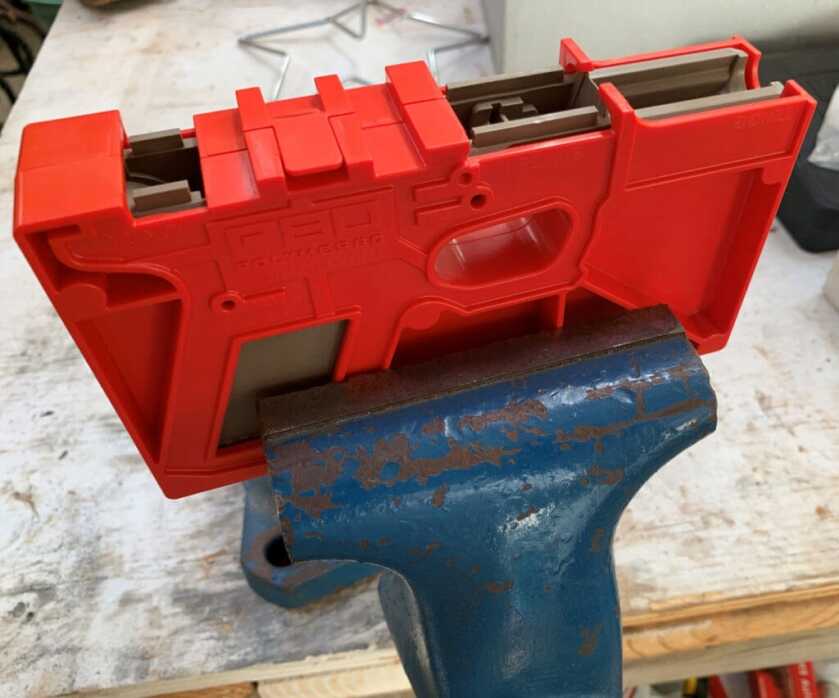
The Polymer 80 Frame came with a fixture, as well as the drill bits needed to complete it. A lot of people building firearms are using drill presses or milling machines to “machine” these. After doing some looking I came to the conclusion that it was not really necessary to have that kind of equipment for this project. I used a hand drill, a Dremel tool, a couple of files, a vise, and some abrasive cloth (sandpaper would work). You could even leave out the Dremel tool and just use the files. An Exacto knife is pretty handy to have as well, particularly for deburring. You’ll also need a small hammer and some punches for installing the components on the frame.


The first task to be completed is to drill the pinholes in the frame. Polymer80 recommends this be done with a hand drill, using the drill bits supplied with the frame. This kind of surprised me when I first read it. But that’s what they recommend, and it fits pretty well with my theme here anyway. Pay close attention, because there are two different sized drill bits, and they’re not that much different in size. Make sure you use the right drill bit for the right hole. The holes on the fixture are marked with what size they should be drilled, so this isn’t too hard to get right if you’re paying attention. Do not try to drill all the way through the frame from one side. Drill one side, and then turn the fixture around and drill the other side.
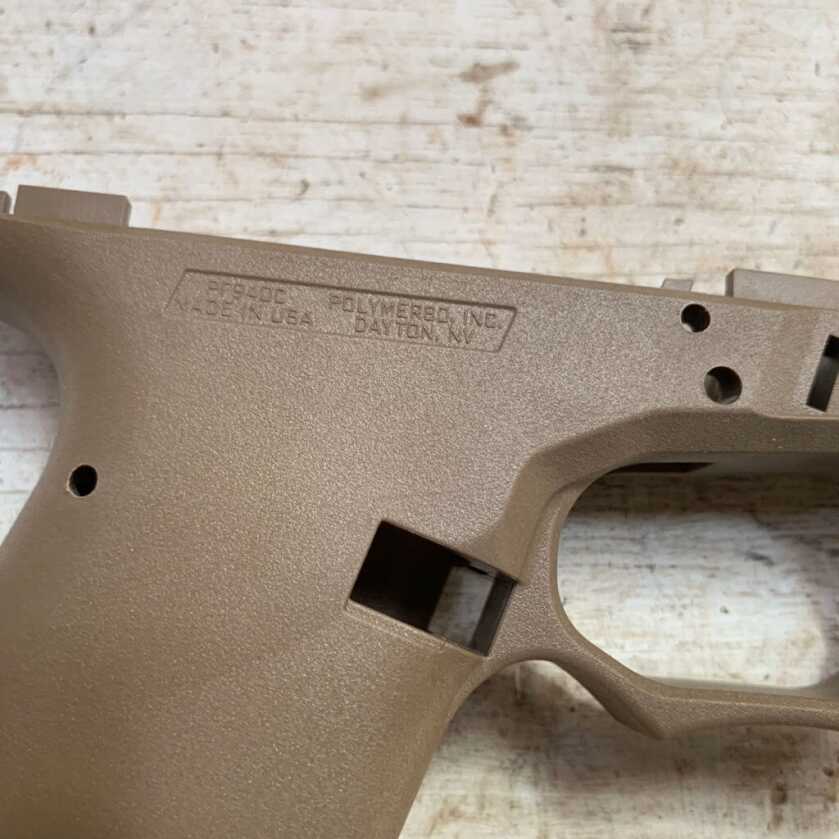

The rail blocks on the tabs are molded on top of the frame to ensure that a slide won’t fit. Obviously, these need to be removed. I used a Dremel tool to remove most of the material. It is REALLY easy to cut too deep with the Dremel. The instructions from Polymer80 say Dremel tools can do WLDQ (a Whole Lot of Damage Quick), and this is definitely the case. So, I left some material as a “buffer area” and I removed this material with a file. An Exacto knife comes in handy for removing the burr that’s created from the Dremel tool, so that you can see what you’re doing a little better. The directions from Polymer80 said to remove material until the frame is even with the fixture. This is a pretty good indicator, but you can pretty well see when you’ve gone far enough if you’re paying attention. Then use the abrasive cloth (or sandpaper) to smooth things out for aesthetic’s sake.

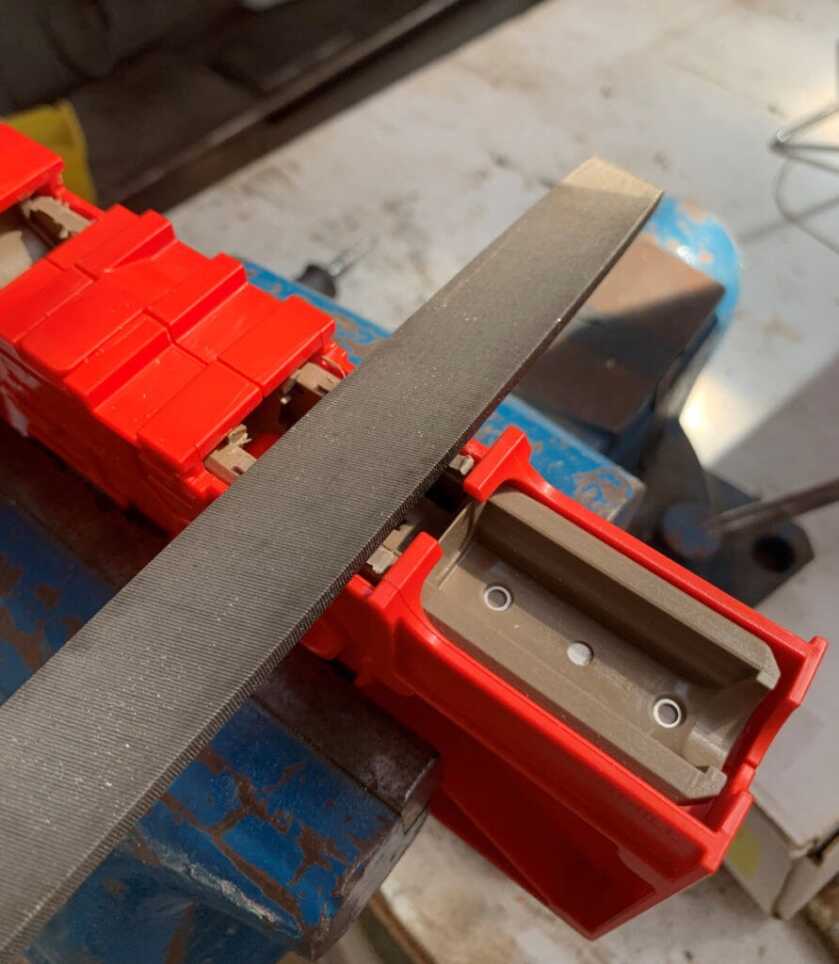
Removing the barrel block is the next step. It’s a little bit trickier to get this done than the rail blocks because you don’t have a lot of room around it to work. Just like the rail blocks, I used the Dremel to “rough” out the area and finished it up with a round file. This area is a bit more critical because parts have to pass through the opening, and the remaining shelf is also necessary. Don’t get in a hurry. Go slow and remove a little bit of material at a time until you are finished.

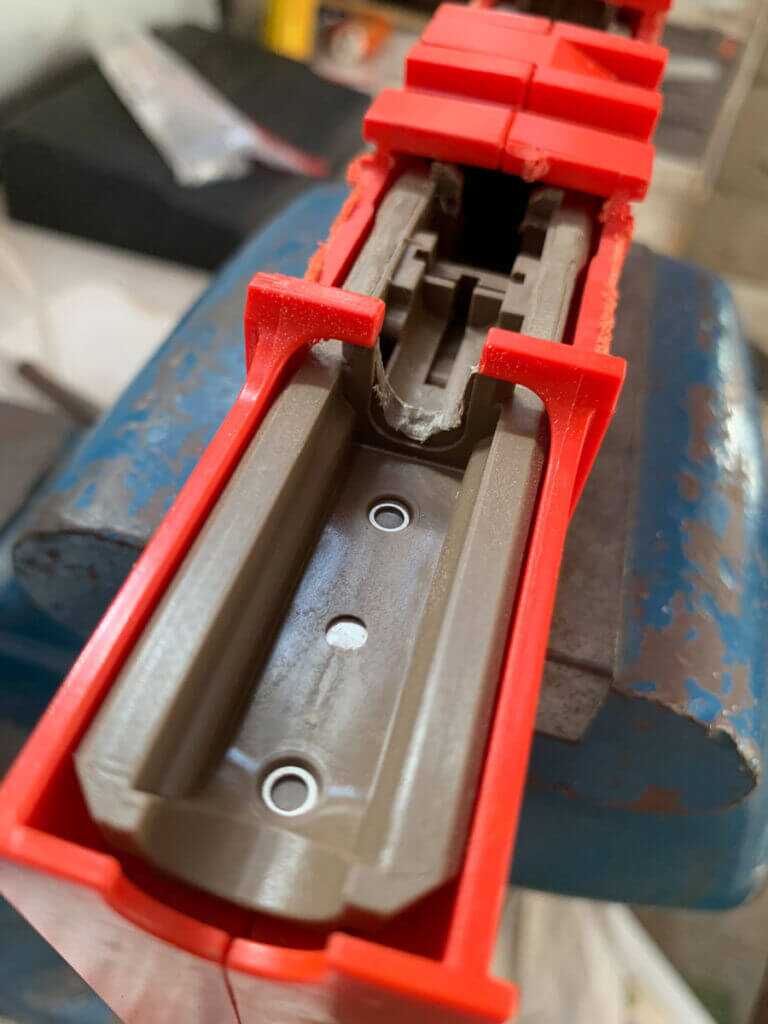
The slide I purchased lacked any kind of metal finish, which you may have noticed in the earlier picture. I had some Brownells Aluma Hyde II in FDE leftover from a previous project, so that’s what I used on the slide. I’m not going to go into the finer points of that here, as almost all of the slides you can purchase already have some kind of finish on them.
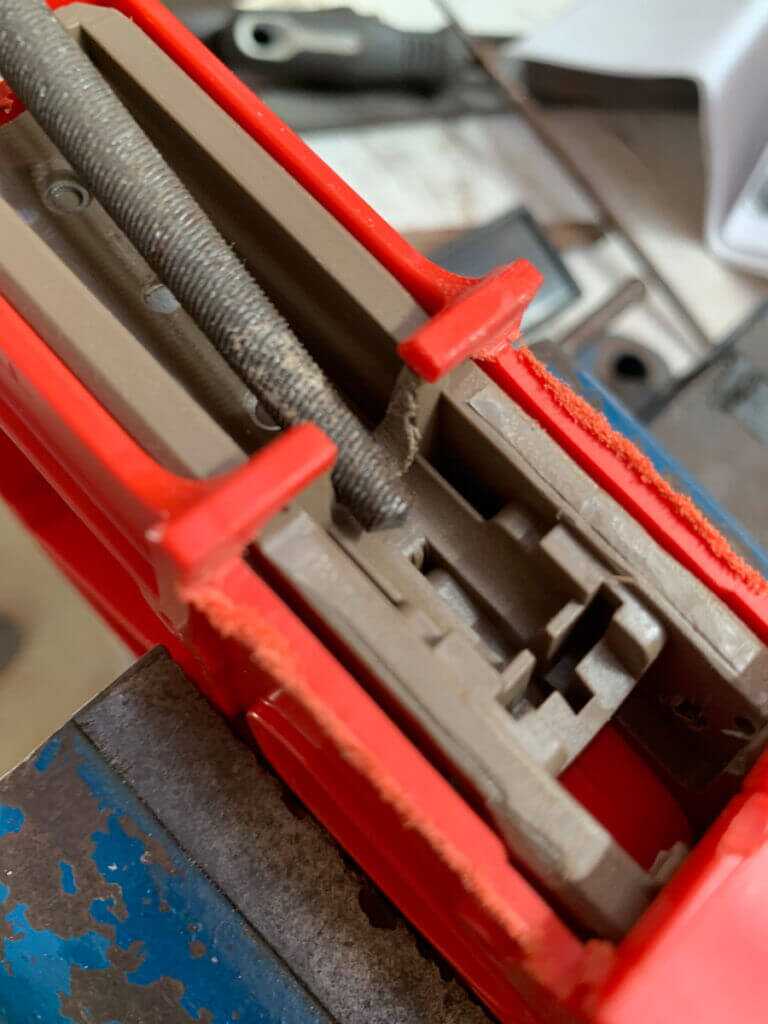

Once the frame has been completed it’s time to assemble the components. Assembly of Glock pistols has been covered many times before and the information is readily available so I’m not going into detail here about that. You can buy preassembled slides if you so desire. Not that it’s that difficult to assemble a Glock slide. I will say that it would be advisable to put the pins in the frame before you install the other parts to make sure they go in place properly. You definitely want to make sure that you remove any remaining burrs left from drilling the pinholes before you proceed. It’s also definitely worth a look in the instructions at the various “tight-fitting suggestions” they have before you start putting parts in the frame.


Once everything is put together, it’s time to do some functional testing. We need to make sure that our trigger mechanism and other parts are working properly before we attempt to test fire it. First, I function test “dry”, or without dummy rounds. You definitely don’t want to perform any function testing with live rounds for safety reasons. At any rate, after ensuring that the pistol contains no ammunition, pull the trigger. While holding the trigger back, pull the slide all the way to the rear and release it. Then slowly release the trigger, while listening for the “click” of the trigger resetting. Then pull the trigger again. If the pistol fails to do any of these things, there’s something wrong in your trigger group. STOP AND CORRECT THE PROBLEM BEFORE PROCEEDING. After I’ve done the initial function testing, then I cycle the pistol with some dummy rounds. I do the procedure above, with the addition of ensuring that the dummy rounds feed, chamber, extract and eject properly. You also want to ensure that the slide lock holds the slide open after the last round ejects.
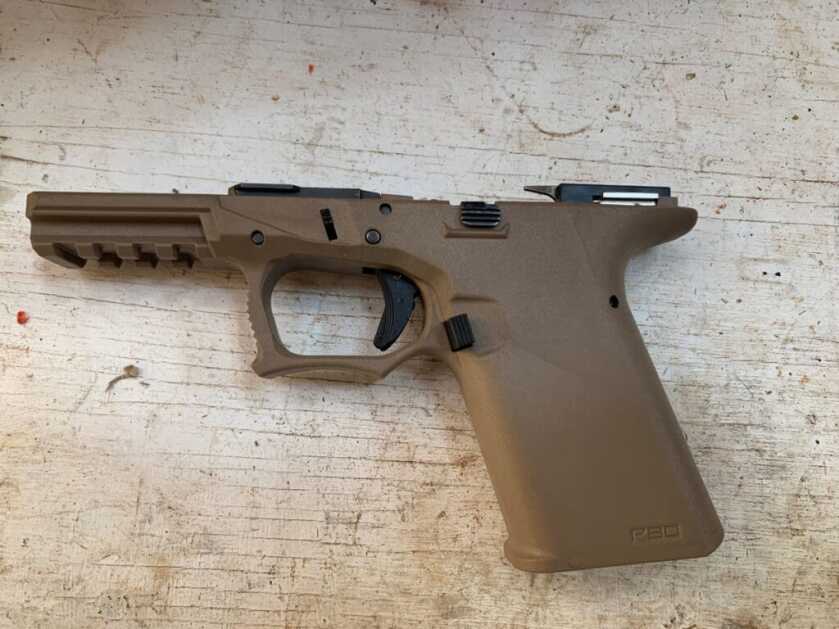
When it came time to cycle the dummy rounds and test fire, I ran into a little snag when I realized that I didn’t have any Glock 19 magazines. The other Glock pistols I have owned have been full-sized models. Fortunately, magazines for the full-sized pistols work in the compact models of the same caliber-though they stick out a bit. So, I test-fired this build with a Glock 17 magazine.

As you can see, it is quite possible to build a firearm without needing a bunch of expensive equipment. It’s very possible that you already have the tools I used to complete this build. The Polymer80 frames really make it possible for almost anyone with a little bit of mechanical aptitude to build a nice pistol. Hopefully, this article has inspired some of you would be homebuilders to give it a shot!

Incredible provides more than simply an improvement to your life. It’s an absolute change!
Your positive mindset is motivating! I’m impressed by your effort as well as dedication.
Incredible can help you obtain even more performed in less time and also with greater convenience than in the past!
You have actually been an amazing asset to the team and have actually exceeded and past in your job. We thank you from all-time low of our hearts.
You have a means of making difficult jobs appear simple. I’m always impressed by your knowledge and knowledge.
Thanks for believing in us when times was difficult. Your loyalty and steadfast support has been a blessing to us.
You can have all of it!
Using visuals was flawlessly timed and also handy in recognizing key points.
You make others feel approved as well as appreciated. You have a lot knowledge concerning the globe.
Can you do a ar-15 one ? Thanks I used your tutorial to build my first p80 g23 works like a charm you’re awesome!!
Nate,
Although I don’t agree with you, I do respect your opinion and appreciate your service more than you can imagine. The Second Amendment was not put in place in order to have self defense or hunting provisions. The Second Amendment was put in place because the people demanded it, the Constitution would not have been accepted without it. It was demanded so that the government could never become what it is now, forcing the citizens to do it’s will instead of honoring and enforcing the will of the people. The government should provide all of the weaponry, as well as training for the proper use of the weaponry, to all law abiding citizens. They should be well qualified to defend the citizens, and well regulated as a Militia separate from any government input or oversight except for the purpose of training on the weapon systems. Those like you that have sacrificed for the freedom of our great nation are my heroes. You deserve more than any politician, you were willing to give all, thank you. Let’s all work together to continue to ensure the freedom for generations to come.
All videos Isee have the trigger already assembled. My kit came TOTALLY disassembled. I mean TOTALLY. Do you have a lead on how to piece this together???
P80 g17 Gen 3
I have been a shooter for 65 years and an off and on member of the NRA. a college graduate, a Viet Nam Decorated Combat Veteran and Honorably Retired Police Officer for 40 years. I hold a life time CCW and a member of the Texas Ranger’s Association.
Bump stocks, trigger attachments for full auto reaction and unregistered gun builds fuel the anti gunners and anti gun violence citizens drive against the 2nd Amendment. You buy a legal firearm registered to you, you reload your own ammo and you go out to a safe, supervised and rule enforced firing range to shoot and then you come home and clean your gun. This is normal and legal and a very easy to enjoy and protect right.
Anything else is nonsense and will eventually cost us our 2nd Amendment rights. If you want rapid fire futuristic gedunk smothered handguns and assault weapons with laser sights and bizarre configured bullets to shoot why don’t you feed your imaginations by going into the United States Marine Corp. Advance through training, become a Scout Sniper and crawl through snake and bug invested jungles and rice paddies. Learn to smoke so you can remove blood sucking leeches and be filthy and itching and constipated from eating MRE’s for months at a time. 58 confirmed and a probable 313 overall, boy that’s a memory you’ll always remember as they spit on you while your waiting for a cab at the airport to go home to your family. The fun part is the night sweats and night terror wakeups for several years after and walking down the street looking at bushes and hedges and diving to the ground when you hear a sharp noise.
So make the legal laws and changes by voting and drop the angle playing and loop hole and fantasy games. Protect the 2nd Amendment by living by the rules.
Sincerely
Nate Jaeger
Natejaeger.com
What an ignorant statement. You, sir, are part of the problem, just like all of the other apologists.
Where do you live that you have to register your firearm, because I live in America and there’s no gun registry here. I suspect you also live in America, but are just clueless.
I might be a bit late in response here, but I can’t believe anyone who considers themselves a 2A advocate would spout crap like this.
Good write up. I tried to use a drill press and lathe bits first time I did one (P80 says don’t use drill press), and the lathe bits dug into the material and frame. Like your approach, Slow and steady is the word.
As an alternative to dremel, on my most recent build I used Stanley 1/2 inch end cutting pliers ($20 on Amazon) to snip off the tabs, that was a much cleaner and easier operation. Give that a try.
Thank you! I was trying to avoid buying a Dremel, I saw your comment and realized I have a really nice pair of cutting pliers from when I worked in a plastic factory…awesome!
I don’t think there is a way to completely avoid having to clean up the pinhole burrs. Any time you drill a hole, you’re going to end up with something, though it might be small enough that you don’t notice unless you really look.
I’ve done of these builds and the author is correct! Very simple and very easy with no specialty tools required! I’m very pleased with it and shoots great!
Good write up, Chris. You’ve removed much of the element of the unknown about tackling this kind of project. Looks like for someone who’s assembled ARs that this would be a lateral move.
The pic of the drill hole burrs makes me wonder if buying a high quality drill bit, i.e. sharper, or even using a different type of bit would produce no to little burring?
I am certainly more interested in doing one now.